Components and machinery suppliers found inventive ways to make their products more sustainable and efficient at the German show.
Sustainable Innovation at Interzum Cologne
After a four-year hiatus, in-person Interzum Cologne was back.
About 62,000 visitors attended the biennial show, the largest components fair for furniture production and interior design held May 9-12 in Cologne, Germany. The event drew a number of exhibitors from the bedding industry, and the editors of BedTimes enjoyed walking through the Koelnmesse halls in search of the latest products and machinery.
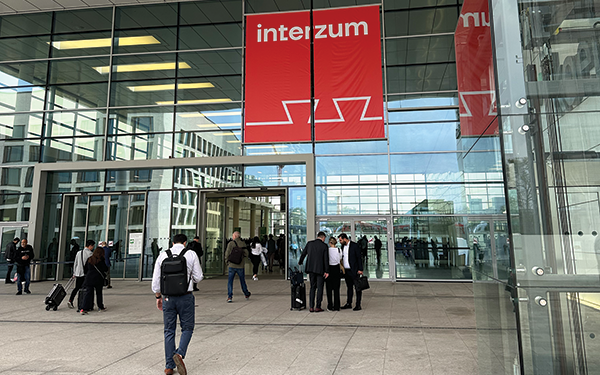

And while the attendance numbers didn’t quite match 2019 (a record-breaking year), they were respectable. The show welcomed roughly 1,600 exhibitors, and attendees from more than 150 countries. The largest number of visitors came from Germany, Italy, Spain and Poland, and Turkish visitors were up by 16% compared with the previous market. The show also saw an increase in visitors from India, according to organizers.
Interzum Cologne selected sustainability as a theme for the show, and it proved timely. Bedding industry exhibitors consistently spoke about sustainable processes at their companies or brought components and machinery designed to make disassembling and recycling parts of a mattress easier.
While it’s simply not possible to visit every bedding supplier or even write about everyone we saw, we hope you enjoy some of the finds from the show on the following pages.
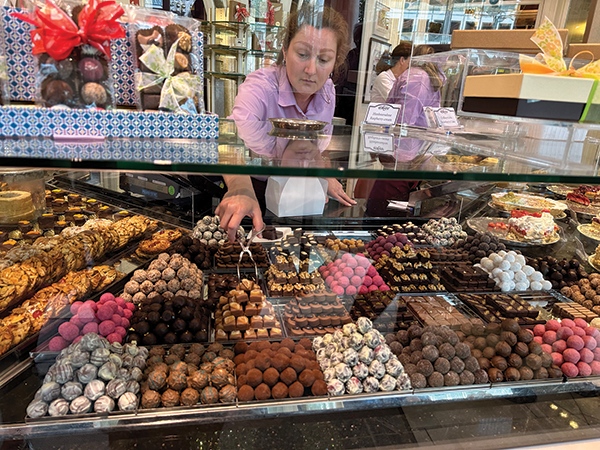
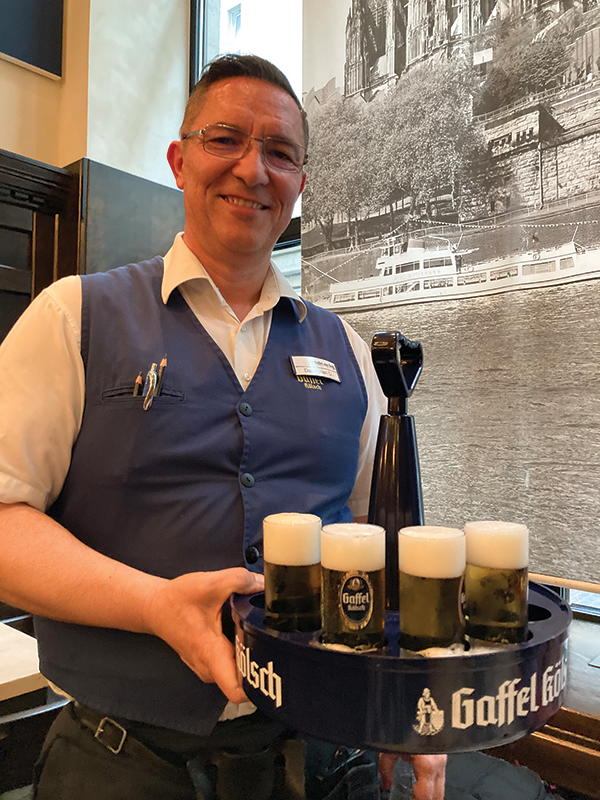
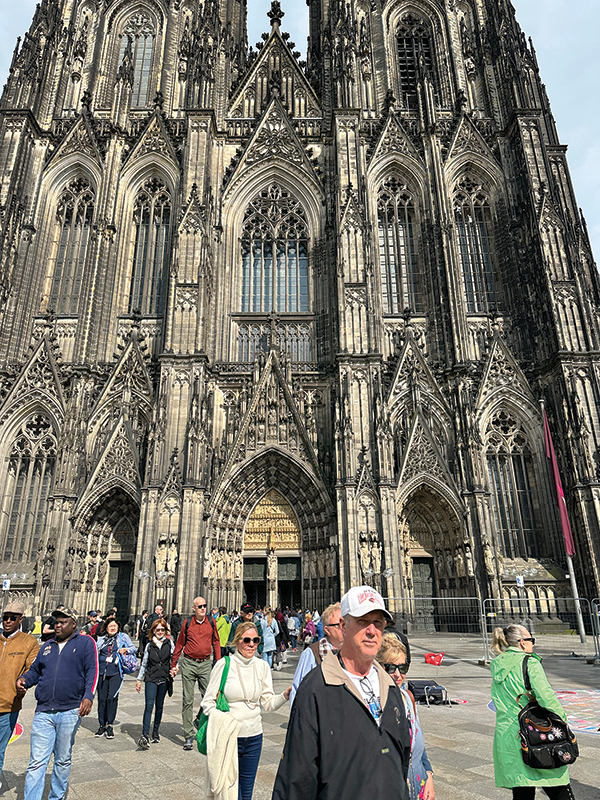
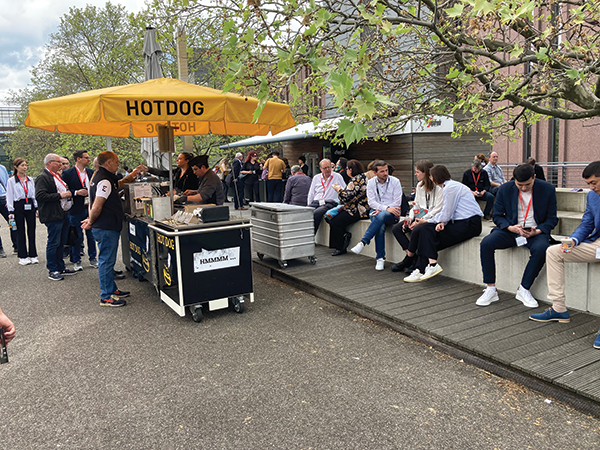
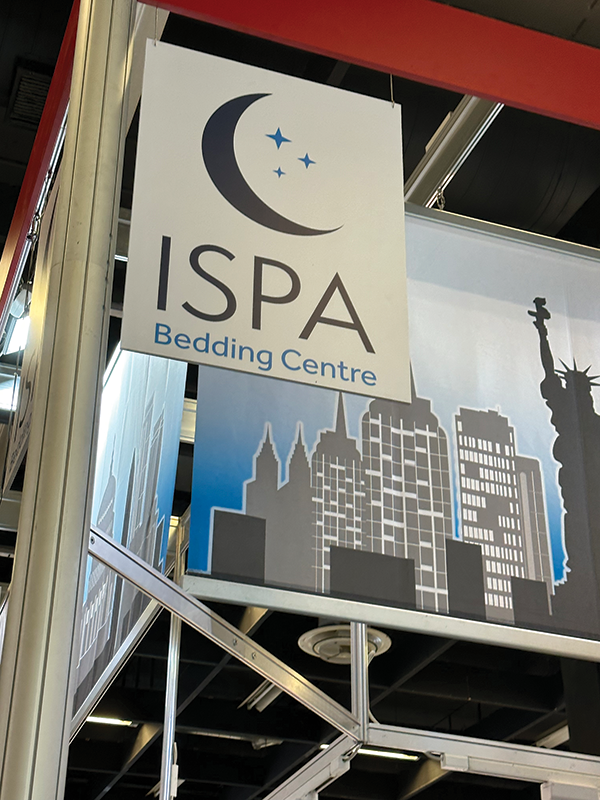
Ticking Takes on Timely Innovations
Most ticking manufacturers we spoke with are aiming for one goal: 100% recyclability. And of course, we also uncovered some interesting new innovations.
In a company first, BekaertDeslee earned sixthe Interzum Awards, including the Best of the Best 2023 for Smartsleeve, a mattress enhancer made for the circular economy.
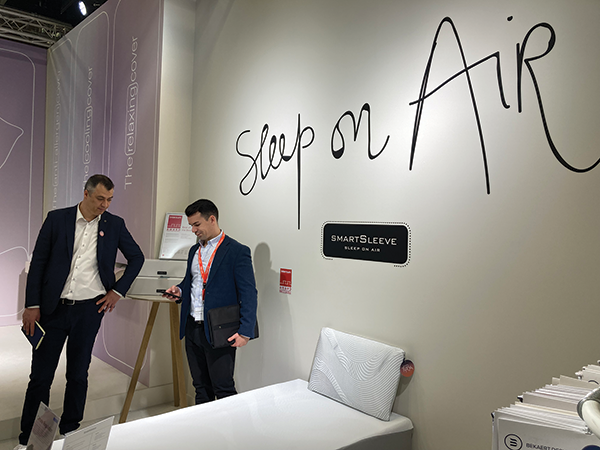
Why is it the best of the best?
“Actually, it’s an all-in-one solution, which has all our best features,” said Kim Pint, product manager at the Waregem, Belgium-based company. “It has our improved allergen-reducing Purotex+ (powered by HeiQ AllergenTech) technology, our Adaptive treatment for wicking and moisture management, and our Cairfull breathable construction.”
All these materials make the protector 100% recyclable. “We tested it,” Pint said. “We put them in the shredder, and then we made pellets, which can be used to make new yarn with it.”
She said the company makes transparency a priority, not only by being as clear as possible about the product and the production, but also by choosing recycled materials, such as Seaqual, a yarn made from plastic ocean waste. (Find a link for all the awards winners on page 34.)
Just in time for Interzum, Sunds Textiles A/S, based in Sunds, Denmark, completed a 100% recyclable mattress cover.

“I have been working for a long time to make a cover that is 100% recyclable,” said Susanne Thygesen Nors, designer for Sunds Textiles. “That means it’s the zipper, the yarn, the label, the tape. Everything! The sewing thread … I’ve been asking for the zipper for two years, and I just got it eight days before packing the container for this show.”
Nors noted that the new cover can come in any color or design, and it can have a more eco-friendly look or be fashion-forward. Sunds is constantly working to create new patterns and colorways, she said.
“One direction of our patterns is classic,” Nors said. “But in recent years we’ve made a lot of sporty designs with gray and a little stronger blue, yellow or orange. The pattern is complex, but I work to make it look unbusy and simple.”
As at Sunds, the environment also took center stage at Maes Mattress Ticking, which is embarking on a new sustainability program. “We believe the future of our business is sustainable. Infinite is our program to get there,” reads the company brochure.
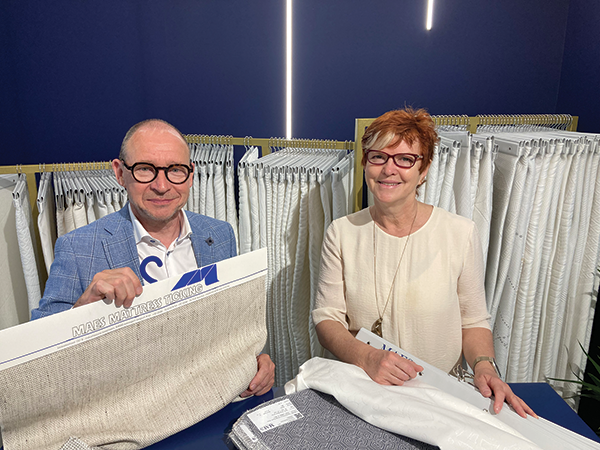
The new program will reduce Maes’ operational impact, as well as guide its products. “We try to produce in a sustainable way, using the most sustainable yarns and products in the industry,” said Bart Desmet, director of business development at the Zwevegem, Belgium-based company.
“We’re mainly focusing on natural compositions and natural yarns: viscose, Tencel, wool, cotton, hemp, flax linen,” he continued. “Everything that is natural; that’s what our customers are sourcing and looking for. So, that’s what we’re bringing out.”
At Boyteks, a combination of sustainable and dramatic fabrics filled the booth. First the sustainable: Boyteks received two High Product Quality Awards from Interzum for its BioGreen and Nettle lines. BioGreen fabrics use bio-based raw materials to make textiles with a variety of properties, such as BioSoft, BioDry, BioOdor and BioCool.
Nettle, as the name implies, is made from nettle plant fibers, which are an alternative to cotton. Advantages include less energy and water consumption during nettle production. The nettle fabric also absorbs moisture, keeping the skin dry for a more comfortable night’s sleep.

Additionally, the Kayseri, Turkey-based supplier showcased its ReTurn mattress fabric, which is made from polyester yarns with added enzymes to help it biodegrade faster than untreated polyester fabric.
And now for the dramatic: 28K. Aydin Aydin, brand manager, called it high-resolution ticking. With intricate and striking patterns, the fabrics made a powerful statement.
Lava tackled the difficulty of recycling mattress ticking with a biodegradable fabric, EcoSolve, which won an Interzum High Product Quality Award. Made with Ciclo polyester yarns, the ticking biodegrades like wool when a high temperature and moisture are applied. It’s also easy to recycle, said Lucas VonWelden, co-owner of the Wielsbeke, Belgium-based supplier.
In addition to keeping sustainability in mind, Lava also highlighted two cooling fabrics — Triple Jersey Claudia and Arctic. Triple Jersey Claudia is the coolest fabric Lava has available, with double the amount of cooling yarn. Arctic, previously only offered in white, now comes in a heathered black.
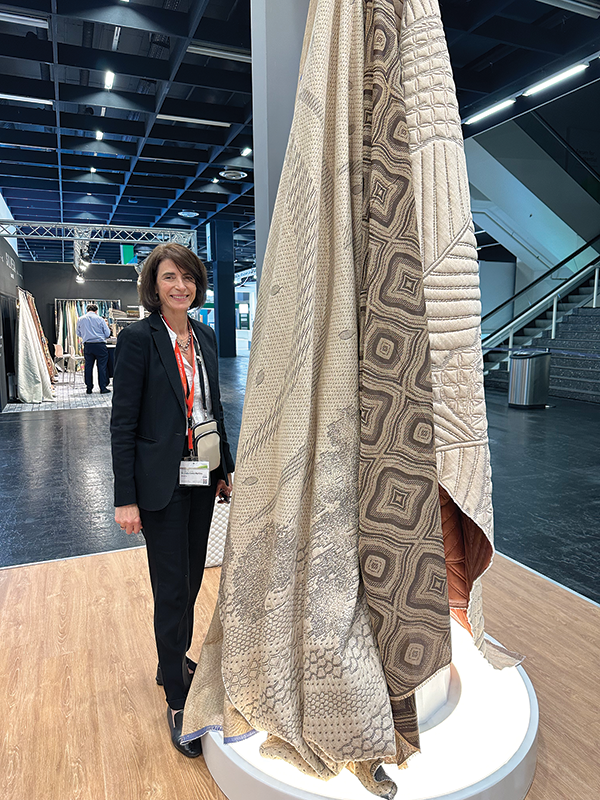
Next up: With the booth tagline “Textiles for a Sustainable Future,” Duvalli showcased fabrics made from recycled textile waste, as well as a novel fiber — yarn made from cork. “It’s light, flexible, sustainable, hypoallergenic and offers natural protection without having to have finishes,” said Lígia Martins, account manager for the textile provider, based in Santa Maria de Feira, Portugal. The resulting fabrics — knit and woven — are long-lasting, she said.
Madrid-based Entex showcased Relife fabrics, its most natural and sustainable line. The fabrics are manufactured with an eye toward reducing the use of energy, water and chemicals, as well as CO2 emissions. The line also includes fabrics made with Seaqual, a recycled polyester yarn.
At Kayseri, Turkey-based Kucukler Texstil AS (Comfytex), a Biosalt fabric finish stole the show. Just as Himalayan salt takes its name from the region where it is found, the salt used in this treatment comes from Cankiri, Turkey, so it’s called “Cankiri salt.”
“It gives a relaxing effect because of the negative ions that it emits,” said Mustafa Durmaz, sales specialist at Comfytex. Negative ions also help to decrease dust, pollen and bacteria in a bedroom’s air.
“This technology brings the feeling of comfort present near the sea and rivers to your bed,” according to a company brochure. Comfytex also showcased another new finish called Passiflora, which it claims induces a deeper sleep by reducing anxiety, thanks to the benefits of soothing plant-based aromatherapy.

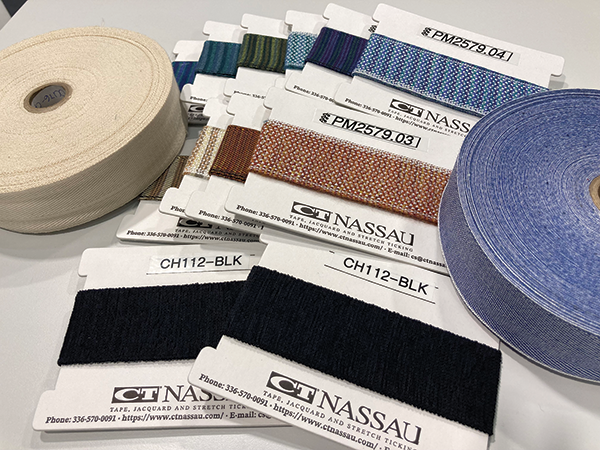
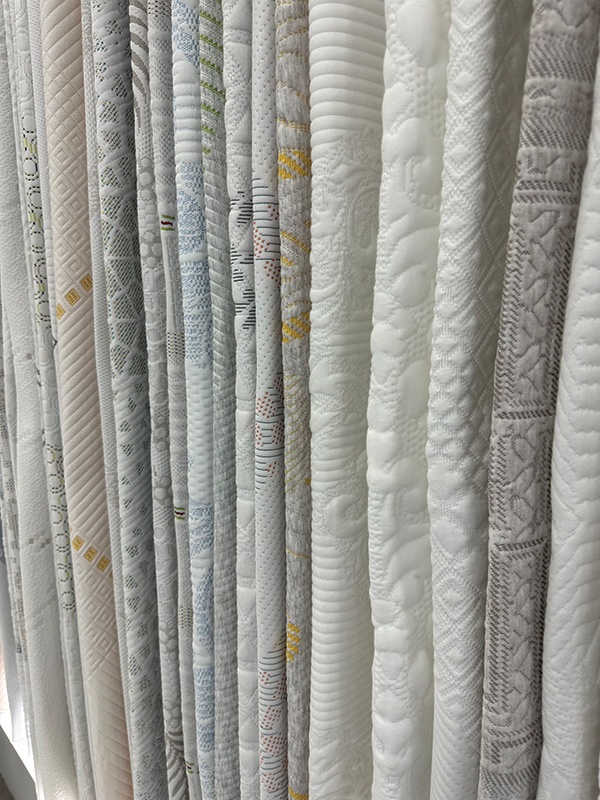
Entex highlighted its Relife fabrics.
Speaking of innovation, CT Nassau, part of the Stellini Textile Group, introduced a chenille tape in black and navy, with more colors on the way.
“We were able to come up with a new way to construct the chenille tape within our plant that has given us a new and improved tape that is very affordable and runs extremely well in the mattress factory,” said Taber Wood, vice president of CT Nassau, based in Alamance, North Carolina. “The quality and price point have been well received.”
The chenille is not only for tape; the company also domestically produces the same look and color for mattress handles and borders. “So, our customers are able to coordinate the border, the handle and the tape with the chenille,” he said. “Nothing says luxury better than CT Nassau Chenille.”
Bedouin Pvt. Ltd., headquartered in Lahore, Pakistan, offered an attractive display of zippered mattress covers. A bed cover producer for more than 20 years, Bedouin has focused on zippered covers because it feels that’s where the mattress industry is headed, said Naveed Bashir, director. “As time goes by, it will gradually move more toward zippered covers because of the manufacturing process,” he said. “It’s constantly evolving. You just have to go around this show to realize how much technology is in automated mattress manufacturing.”
Love Home Fabrics, which encompasses several textile and foam companies, including Global Textile Alliance and Talalay Global, introduced its newest company — Novaya. The company comes from the merger of latex and foam companies Atrilat and Latexco. It offers three types of latex — Dunlop, Pulse and Talalay — as well as specialty foams. Love Home Fabrics’ large booth featured themed corners, which blended the brands into one space. The themes included luxury, modern, ecological and cozy. “We’re here to inspire,” said Gregory Tack, director of Love Home Fabrics.
Coil Makers Embrace Circularity
Many springs makers focused on developing products that can be dis-assembled and recycled at the end of a mattress’ life.
For example, springs manufacturer Agro featured its A.Next Arise, a circular pocket innerspring. Made with recycled wire and recycled nonwoven fabric, the product was awarded an Interzum High Product Quality Award. “We can really be proud of this,” said Martin Mannel, group sales director of the Bad Essen, Germany-based company. The nonwoven and adhesive are both made from polypropylene and can be melted and reused, he said.
Four years after Spinks first brought its accordion-style glueless Flexicore coils to Interzum Cologne, it brought them back — but in a different size. The original wrapped springs stood at 5 inches, but the latest renditions are 3 ½ inches tall. “That allows for greater flexibility, more possibility,” said Chris Balmer, global sales director for the Leeds, England-based company. Spinks also introduced Microplus, 2-inch microcoils, good for crib mattresses and mattress toppers.


Spinks showcased a number of coils, including the 2-inch Microplus.

The Boycelik booth proclaimed “Go Green” above a display of its individually wrapped coils. The Kayseri, Turkey-based supplier displayed its latest springs innovation that contributes to a greener world — C-Cycling. These pocketed coils are constructed from wire, nonwoven material and an adhesive that can be recycled, said Feridun Tosun, international sales and marketing director. The springs manufacturer also highlighted R2S, a foam-encased unit with pocketed coils in the center. It’s designed to shorten mattress production time.
Starsprings brought several innovations to the show. It’s S-Touch coils feature foam and coils integrated into one individually wrapped pocket. The pockets are welded together, which makes the product easier to recycle. It’s also convenient for manufacturers — the product can be customized according to zones, softness and size. A foam rail isn’t necessary, although manufacturers could choose to use one, said Rafal Modrzycki, senior key account manager.
Another display showed PET (a recyclable polyester) pockets that are coming soon. And then the S-Matic provided a different take on personalization. Instead of using air chambers to adjust comfort preferences, the Herrljunga, Sweden-based springs maker used a motor that controlled raising and lowering a zig-zag style spring (a type usually used in sofa cushions) to make the mattress firmer
or softer.
Foam Advancements Create Softer, More Sustainable Formulations
The foam and latex category drew attention for its new formulations with sustainability in mind.
The Vita Group walked away with an Interzum Best of the Best Award for its Vita First mattress.
Manufactured using sustainable technologies, it includes a layer of concept foam Orbis Plus MB (mass balance), a layer of reconstituted foam Novus and a sustainable cover made with Global Recycled Standard ticking. Orbis Plus MB, which won an Interzum High Product Quality Award, is a sustainable foam that uses bio-circular mass balance TDI (produced by Covestro) and as much as 100% renewable and recycled polyol. According to the Middleton, United Kingdom-based company, “Mass balance is the certified methodology to bring more sustainable raw materials into complex production chains.” The mattress itself contains no adhesives. Instead, its foams are contoured to fit together.
The Vita Group also won an Interzum High Product Quality Award for its Orbit Next MB, another sustainable, flexible polyurethane foam that uses as much as 100% recycled polyol and certified bio-circular MB TDI.
LSK Napure Latex continued its focus on health and sustainability with its latex. Malaysia’s largest latex producer, LSK highlighted its Global Organic Latex Standard and Forest Stewardship Council certifications. Its latex provides seven zones for comfort, including a softer shoulder zone and firmer lumbar support, and it’s aniline-free, said Ratna Dewi, general manager.
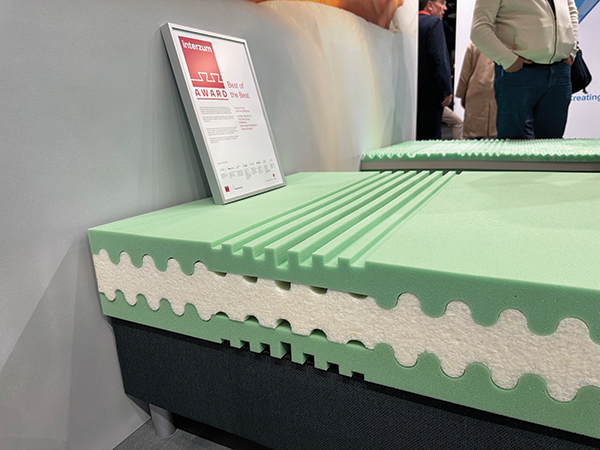
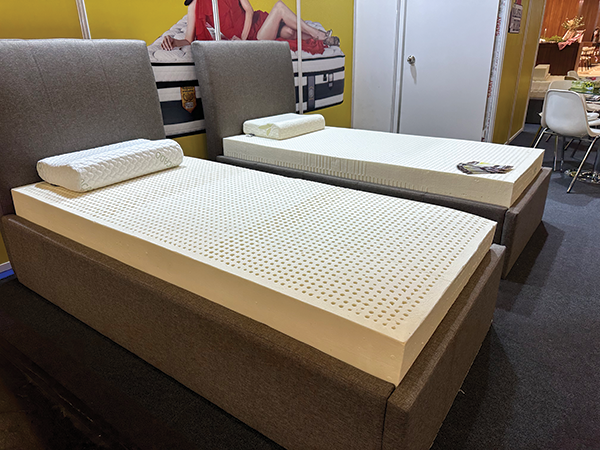


GommaGomma’s booth was striking. Inside the booth, in large white letters on a yellow background, the Italian foam producer proclaimed “It was a fake.” Just below, it continued: “Now our latex is 100% natural and more sustainable.” GommaGomma and Sri Lankan latex producer Arpico have joined forces so that GommaGomma can distribute Arpico to the European market.
On the outside of the booth, the producer introduced its Uniq-Foam. The new formulation is used in pillows, chairs and mattress toppers. The perforated pillow offers airflow and can be manipulated like a feather pillow. “Hug it, squash it, squeeze it, fold it. … It will return to its original shape,” the company’s marketing materials state.
In another area of the show, Arpico brought its newest latex products: a layer made with cooling gel beads, a layer that acts as an FR barrier and softer pillows, achieved by lowering the density. Shaminda Yaddahige, chief operating officer, also noted its quilting layers can now be made wider.
Technology Expands Into New Frontiers
While it’s not officially a bedding category, technology showed up in all kinds of spaces.
One of the most interesting technological developments came from Triple R, a company founded by two former BekaertDeslee managers. This technology embeds RFID into a mattress, linked to a cloud platform which contains information about each product. It also offers a QR code on the label for the consumer. Each mattress has a unique identifier, which allows all stakeholders (from manufacturers to consumers to recyclers) to follow the life cycle of the mattress or simply track it for logistics.
“Its main purpose is to increase recycling,” said Rik Holvoet, co-founder of the Ghent, Belgium-based company. “If the composition is not known, it’s hard to recycle. After 10 to 15 years, that information is lost. In the digital world, nothing gets lost.”
Textile producer Lava added a virtual showroom to its booth. It’s an opportunity to show different fabric ideas without having to knit it, said Lucas VonWelden, co-owner. With the touch of a button, customers can take a look at finishes, collections and colors, and within those categories, viewers can see the fabric in different colors and patterns, as well as what it would look like with select borders.
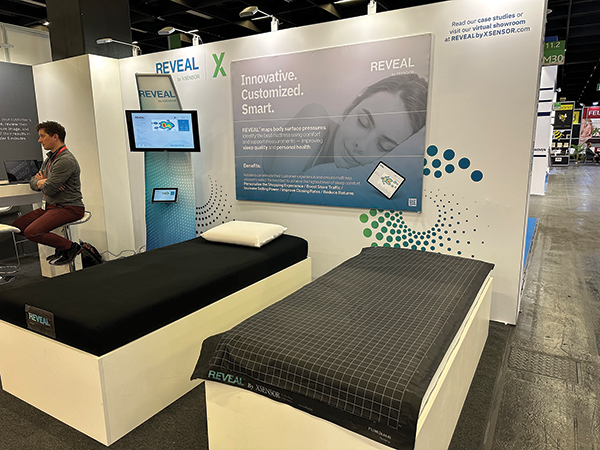
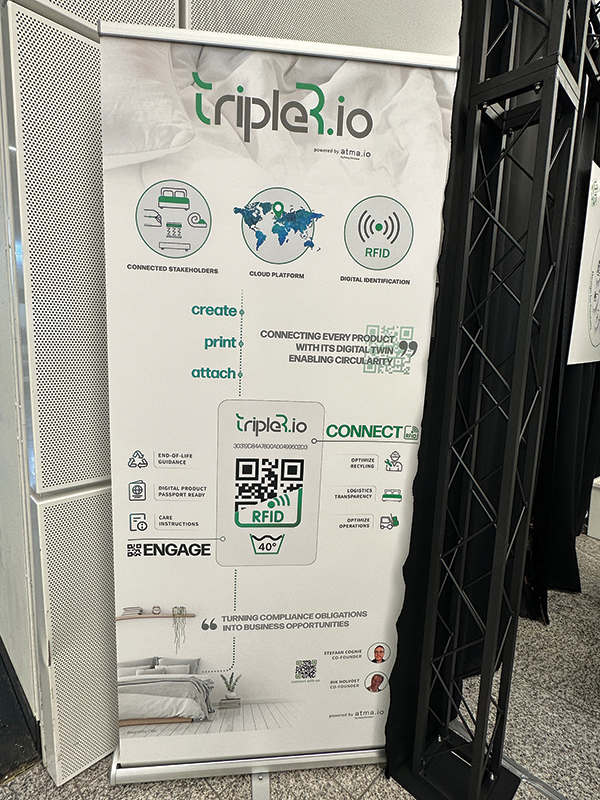
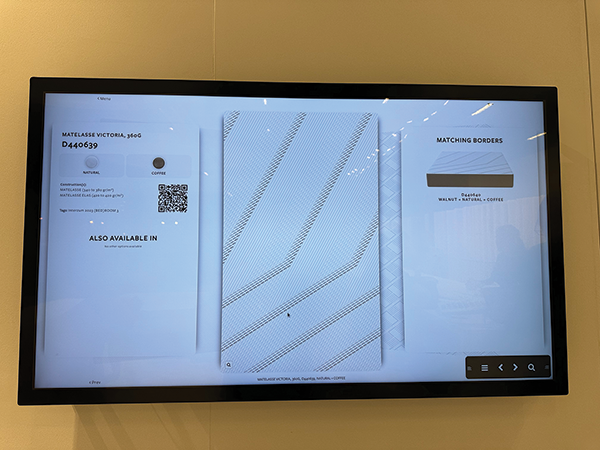
Boyteks brought its new Boyteks Studio, a software program that allows customers to essentially create their own bed. First, they select a bed model, then choose the ticking design. Users can select different borders, tape-edges and logos and can get a 360-degree view of the bed.
Calgary, Canada-based Xsensor Technology Corp. showcased two retail software programs with updates. The Educate software helps retailers recommend a category of mattress for the shopper. When the consumer lies down on a mattress, the software maps pressure points and suggests a mattress category that would ideally help them find a bed that would redistribute the pressure more equally.
The other software, Compare, is mobile friendly. As the name suggests, it allows the consumer to go from mattress to mattress and compare pressure points. “Both are effective in engaging the customers and increasing the traffic in the store,” said Danny Richards, director of business development.
Machinery Moves Toward Efficiency, Sustainability
Equipment makers brought new machinery with an eye toward automation and reducing waste.
Atlanta Attachment Co. garnered a lot of buzz at ISPA EXPO in March 2022 with its recycling machine for pocketed springs. At Interzum, the Lawrenceville, Georgia-based machinery supplier showed an updated version. Design changes have increased efficiency and output, said Doug Guffey, senior vice president of sales. It can separate metal coils from the pocket fabric at a speed of 12 to 15 queen-size units per hour. “It’s almost double the output than originally thought,” he said.
Global Systems Group, the machinery division of Carthage, Missouri-based Leggett & Platt Inc., used a portion of its space to simulate an auto production line for hybrid mattresses. The benefits of an automated line include reduced labor, greater efficiency and less waste.
GSG also showcased a new loading robot, the TK810 Automatic Sock Covering Machine, Ultra HCB Ergo Binding Machine and the Mattress Master Elite auto tape-edge machine. The tape-edger allows an operator to sit or stand in one position. Once the sewing on one side is completed, the machine will flip the mattress so the other side can be sewn. “There’s a consistency in the look of the product,” said Paul Block, president of sales. “It deskills the tape edge.”


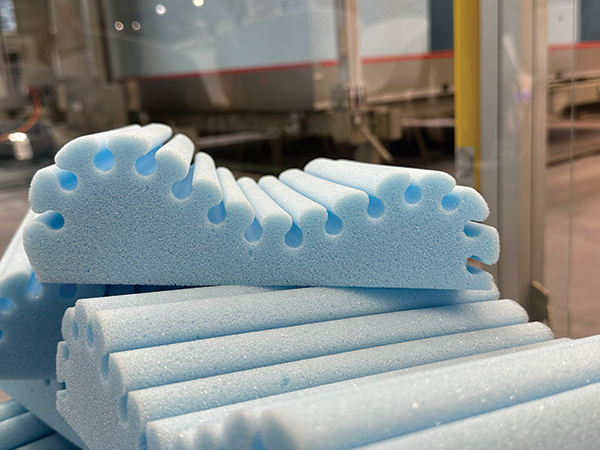
polyurethane foams into any shape.
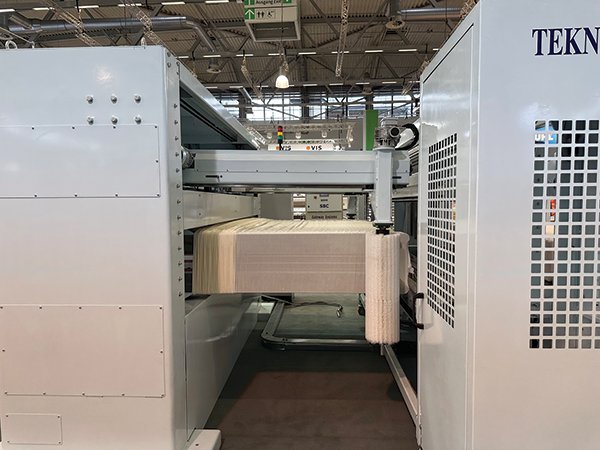
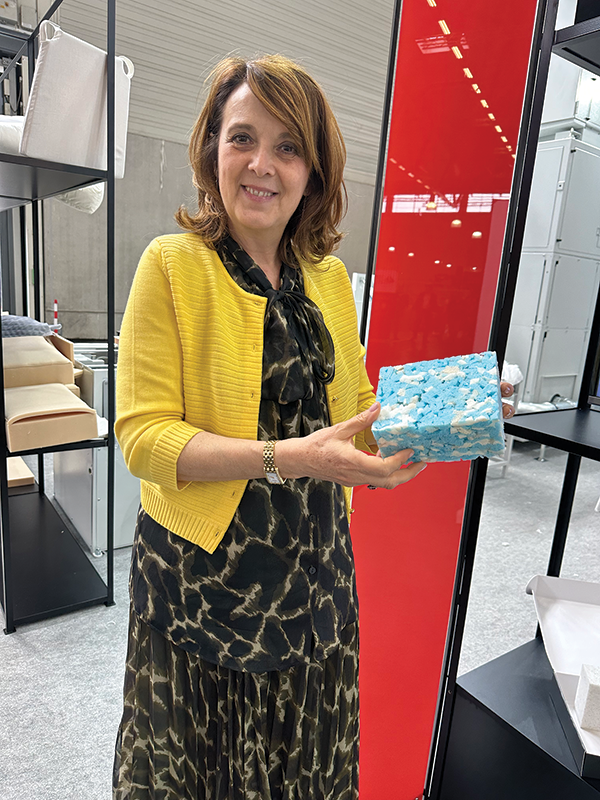
Girona, Spain-based Masias Maquinaria offered a line of machinery that can turn scrap materials into replacements for foam or comfort layers in a mattress. Called Flexipad, the line can manufacture a wide range of products by mixing a thermobonding fiber with different foams or fibers and loading them into the system. In addition to using manufacturing scraps, bedding producers can also add synthetic fibers, such as polyester, Lyocell or shoddy, or natural fibers, such as cotton, wool or hemp. The result is a circular and cost-effective product, according to the company. “Scraps are not waste; they are actually an asset,” said Sonia Ortis, sales adviser.
Brighi Tecnologie Italia s.n.c., headquartered in Forli, Italy, has a similar vision for waste material. Brighi has created machinery to use mattress manufacturing scraps and waste. “It’s a pity to throw away material,” said Milva Morani, global marketing officer. Several clear bins in the booth showed fabric scraps, before and after processing, and other materials, such as shredded foam and opened fibers. Each could be used in combination to fill pillows, or foam scraps could be bonded into a new foam product.
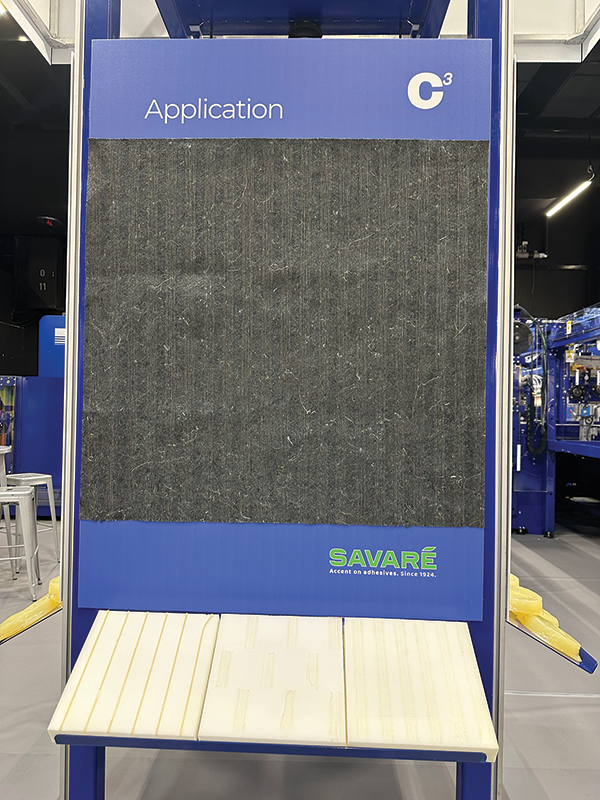
If reduction is the name of the game, C3 has a solution for mattress makers. The Appleton, Wisconsin-based machinery provider has created a hot-melt application that reduces the amount of adhesives needed to put a mattress together. Partnering with Milan-based Savare, C3 offers three ways to apply hot melt. The Hot Melt Bridge can spread adhesive in regular beads, spread it into smaller beads or can even space out those smaller beads. The result is less adhesive used. “You put the glue where you need it,” said Joseph Van De Hey, CEO and company founder.
Matsushita Industrial Co. Ltd., which makes Tecmic pocket spring machinery, was all about cotton. It brought its Cotton Pocket Spring Machine PKT-CT and Cotton Pocket Assembling Machine PKTA-CT. Instead of using nonwovens for the coil wraps, these machines sew cotton around the coils and then attach the rows together with C-rings. The spring-making machine can create 60 pieces per minute, according to information from the company, headquartered in Osaka, Japan.
Hengchang, based in Dongguan, China, featured the HC4000, a high-speed computerized multineedle chain-stitch quilter. “It’s very quiet and safer,” said Ariel Feng, international sales. “It’s easy to design and easy to learn. It has more than 200 patterns.”
Sustainable options are included in new roll-pack machinery from Dolphin Pack. The equipment supplier, based in Affi, Italy, created a new version of its main roll-pack machine — the Etesian Smart Hybrid. Users can choose to roll pack mattresses in plastic or opt for paper, a more sustainable option. “This machine was born to do both,” said Anna Montresor, sales and marketing executive. The machine also takes up less space, coming in at less than 40 feet (12 meters).
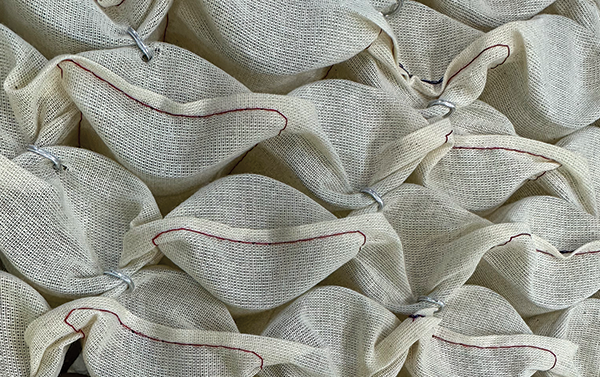
Mert Makina offered an automation solution with its M-7500 Automatic Panel Hemming Machine and M-7000 Automatic Panel Palletizing Machine. When a mattress comes off the quilter, the machine sews edges on all four ends and stacks the panels. “Everyone is looking for automation,” said Jim Baptiste, director and sales representative for the Kayseri, Turkey, company. “That’s where the industry is headed.”
Foams receive the special treatment with Aachen, Germany-based Fecken-Kirfel GmbH & Co.’s C67 Jumbo. The machine offers horizontal contour cutting for polyethylene and polyurethane foams. The rotating bent knife cuts with precision as the table rotates. The result is any type of shape desired.
As Strong as Nature

After a soft launch at the ISPA Sustainability Conference in the fall of 2022, SABA Adhesives & Sealants presented its Sababond 3415 rollable adhesive, with the tagline “Strong as Nature.” “It works very well for edge-to-edge pocket coil mattresses, which we see more frequently in the market,” said Chris Belterman, product marketing manager of SABA, with headquarters in The Netherlands and a U.S. subsidiary in Kimball, Michigan. “Since the non-woven sheets that the pocket coils are wrapped in are more difficult to bond to, we have designed this adhesive that really bonds well with foam to nonwoven, and, not to forget, it’s bio-based.” In addition, the company gave demonstrations of its sprayable “superhero” Sababond 3392. “It’s water-based with a fast initial tack and a strong bond,” he said. “It also works with all kinds of substrates, so it’s really a superhero.”
PURe Products
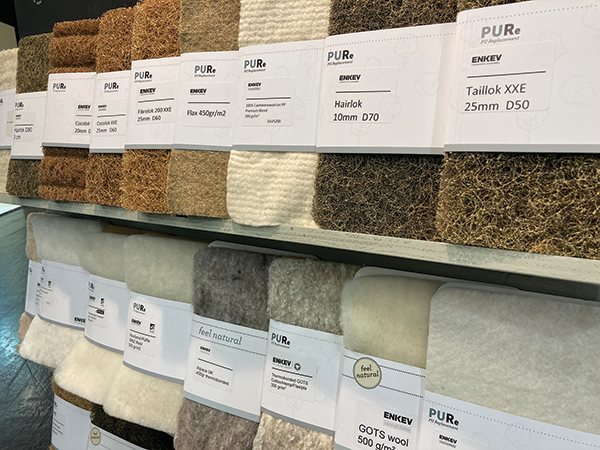
Volendam, Netherlands-based Enkev showcased its Poly-urethane Replacing or PURe products: PURe Circular and PURe Natural. “PURe Circular is materials that you can recycle at end of life, and PURe natural products give you immediate CO2 emission reduction,” said Marc Dokter, commercial director. The PURe Natural line is made from renewable plant-based or animal-based fibers, allowing manufacturers to cut their CO2 footprint six to 20 times compared to PU foam. Part of the Circular collection, Labyrinth is a ventilating layer made from 100% recyclable synthetic fibers. “The real reason for working with our company should not be sustainability; it should be that our materials improve the microclimate (of the bed),” he said. “Just the ventilation part of the mattress is extremely important to achieve with sleep and with health.”




